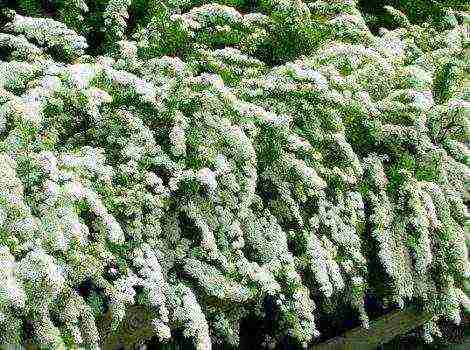Content
 A tree-like shrub called "berry yew" has a rich history. Even in the days of Ancient Egypt, this representative of the plant world was highly valued for its beautiful, durable wood with unique bactericidal properties. Enviable unpretentiousness makes berry yew, planting and caring for which is very simple, a favorite plant of many landscape designers. It perfectly tolerates pruning and allows you to create very interesting garden compositions both in single plantings and in curbs and hedges. The peculiar beauty of Taxus baccata lies in the surprisingly harmonious combination of juicy green needles and spectacular red berries.
A tree-like shrub called "berry yew" has a rich history. Even in the days of Ancient Egypt, this representative of the plant world was highly valued for its beautiful, durable wood with unique bactericidal properties. Enviable unpretentiousness makes berry yew, planting and caring for which is very simple, a favorite plant of many landscape designers. It perfectly tolerates pruning and allows you to create very interesting garden compositions both in single plantings and in curbs and hedges. The peculiar beauty of Taxus baccata lies in the surprisingly harmonious combination of juicy green needles and spectacular red berries.
In its natural habitat, this shrub, and sometimes a whole tree, grows mainly in Europe and the Caucasus. There it can reach 30 m in height, but it is quite possible to grow a small neat specimen in the garden.
Yew berry. Landing
Unlike many horticultural crops, Taxus baccata thrives in shaded areas, but still prefers good lighting. Yew perfectly tolerates gas pollution, therefore it is suitable for growing in urban conditions.
Mahogany loves alkaline soils more, but it can fully grow and develop in slightly acidic soil. Prefers loams and fairly high humidity, but does not tolerate stagnant water well. Absolutely undemanding to soil fertility.
When planting berry yew, it should be taken into account that the distance between the seedlings should be at least 2 m, and the landing site should be well protected from the harsh wind. With single plantings of seedlings, the planting pit, which has a depth of about 60-70 cm, is covered with a substrate of sand, peat and garden soil, mixed in equal proportions. Adding coniferous soil containing mushroom spores to the soil when planting will have a beneficial effect on the growth of yew. Remember that plants with a deep root collar do not take root well and develop well.
When planting, to create a hedge, it would be more correct to immediately dig a trench about 50 cm deep and place seedlings in it with an interval of 0.5-1 m.For a two-row hedge, two trenches with a depth of about 70 cm are prepared at once.
The most optimal planting dates are from mid-August to October, but planting in the spring is also possible, provided that it is protected from possible frosts.
Care for young seedlings is minimal. It is required immediately after planting to add mineral fertilizing for conifers, water and loosen the seedlings every month, remove weeds, mulch the near-trunk circle with chips or sawdust with a layer of up to 10 cm.
Taxus baccata 'Repandens'
Growing care
An adult berry yew practically does not need any maintenance. They only require periodic sanitary pruning and watering during particularly dry periods. To create the most favorable conditions in hot weather, weekly irrigation of the plant crown with water can be carried out.
Young plants during the active growing season will be grateful for spring feeding with a weak solution of complex mineral fertilizer.
Before wintering, it is better to collect the branches of the shrub into a bunch using twine or wire to protect them from possible breakage under the weight of the snow cover.
With the onset of early spring, it is better to shade young Taxus baccata from bright sunlight with spruce branches or craft paper.
Taxus baccata 'Adpressa Aurea'
Reproduction
Yew propagates in two ways: cuttings and seeds.
Seed reproduction is a rather long process, since the yew grows very slowly and by the age of 30 it reaches only 1 m in height. Gardeners who have chosen this difficult breeding method should know that yew seeds remain viable for only 4 years, and a year and a half must pass before they germinate. In addition, before planting, the seeds must necessarily go through a period of holding at low temperatures, the so-called stratification, which takes 3-4 months.
A much more reliable and fast breeding option is cuttings. For this, cuttings are cut from lateral or vertical shoots. The branches should be between 3 and 5 years old. This is done in spring or early autumn. Cuttings from vertical shoots will result in a tall tree, and a sprawling bush will grow from horizontal cuttings.
The prepared planting material is soaked in a growth stimulator, and the needles are removed from the bottom. For the substrate, peat and sand are mixed in a 2: 1 ratio.
In spring, cuttings can be planted directly into open ground, protecting them from frost with a small greenhouse. The entire rooting period, which usually takes about 3 months, is regularly watered to prevent drying out. In autumn, plantings are made in specially prepared containers, which are kept warm until spring, without forgetting to moisturize.
The greenhouse must be removed from the cuttings planted in open ground at the end of August so that the plants have time to undergo hardening before the onset of negative temperatures.
Taxus baccata 'Overeynder'
Yew berry in landscape design
Both European and Oriental landscape design is not complete without this shrub, whose evergreen needles are a wonderful decoration for gardens and parks. It is great for creating hedges as well as garden sculpture. The variety of decorative forms allows you to choose a suitable specimen for both a spacious park and a small garden. Single landings, especially decorated with bright berries at the end of the flight, also look very impressive, for example, on an alpine slide.
The most suitable varieties for planting in central Russia are such varieties as the widespread low shrub Repandens or the small (up to 3 m) frost-resistant Adpressa tree, with short, raised, crowded branches.
How useful was the information for you?
votes (
, rating:
out of 5)
The genus of yew has 8 varieties of monoecious or dioecious evergreen shrubs and trees. In the wild, yew is extremely rare.
A sieve-boxwood grove is located one and a half kilometers from the Caucasian resort of Khosta. In the upper part of the Alazani River there is one of the largest groves of berry yew, its area is more than 800 hectares, and the average age of plants is 350 - 500 years, in some specimens the age has exceeded 1500 years.
It is worth remembering that all parts of this plant are poisonous, only the seed grape is safe.
Yew tolerates drought very well, it has a highly developed root system and is able to get water from the deepest aquifers.
Yew care
It is advisable to use Kemiru Universal during the landing process. In the spring of next year, you can apply mineral fertilizer.
You need to water the plant once a month, 10-12 liters will be enough. Sprinkling is done every two weeks. Loosening should be done only in the first 2-3 years to a depth of 10-15 centimeters.
Young plantings must be covered for the winter with a small (5-7 cm) layer of peat. In addition, under the influence of cold, they become very fragile and break from the accumulated snow, so they are neatly tied into one bundle.
You can protect from burns with kraft paper or spruce branches. Mulching can be done with chips, while the layer should be at least 8 cm.
Adult plants tolerate low temperatures well and do not need additional care. Yew is resistant to heavy pruning and crown formation.Dry shoots can be removed up to 1/3 of the shoot length.
Planting a yew tree
Soil for planting yew: sand, sod land, peat in proportion (3: 2: 2).
Yew can be planted in both slightly acidic and alkaline soils. For pointed yew, loamy podzolic soil is suitable, it is advisable to avoid swampy and acidic soil.
It is preferable to plant the Canadian yew on slightly acidic soils, and the medium yew on slightly alkaline or neutral soils.
As drainage, you can use broken brick covered with a layer of sand 20 cm thick. Yew is very sensitive to high soil moisture and the presence of toxic substances in it, therefore it is unsuitable for cultivation within the city.
The distance between plants should be within 0.6-2.5 m. Planting is carried out to a depth of 60-70 cm, while the root collar should be above the ground.
Reproduction of yew
Reproduction of yew is possible both by cuttings and by germinating seeds. This plant bears fruit for two years in a row, the third year of fruiting is absent.
Seed ripening occurs in autumn, at which time the color of the seed plant becomes transparent and slightly vitreous.
Yews reproduce well by cuttings, and not only fresh shoots are accepted, but also two years ago. Empirically, the feature was noticed that cuttings taken from the branches give vertical, compact bushes.
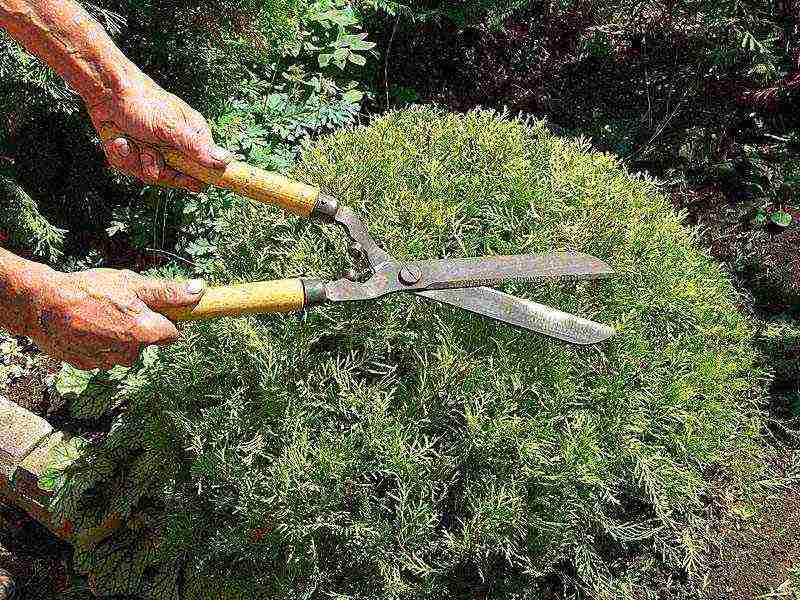
And those cuttings that were taken from horizontal branches produce low, sprawling plants. True, this difference remains noticeable only during the first 100-200 years of a plant's life. In the future, it takes on its natural form.
Yews also reproduce well by grafting and layering.
Using yew in the garden
The use of yew in landscape design is very diverse and depends, first of all, on the type of plant. It is great for forming hedges and looks good both in groups and singly.
Can be used to create alpine slides, container gardening, or group plantings on a parterre lawn.
 Berry yew is held in high esteem by landscape designers due to its originality. This coniferous culture with scarlet drupes looks elegant and elegant in any composition. In addition to good external data, berry yew is distinguished by a long lifespan, simplicity and unpretentious cultivation in the open field. To fully reveal the beauty of the varieties of this plant, take care of the correct and timely planting and care of it.
Berry yew is held in high esteem by landscape designers due to its originality. This coniferous culture with scarlet drupes looks elegant and elegant in any composition. In addition to good external data, berry yew is distinguished by a long lifespan, simplicity and unpretentious cultivation in the open field. To fully reveal the beauty of the varieties of this plant, take care of the correct and timely planting and care of it.
Description: varieties and varieties of berry yew
Berry yew is a unique coniferous culture:
- cones do not grow on it;
- the tree does not emit resins with a characteristic odor;
- wood does not rot, does not sink and has a strong bactericidal effect.
Plant characteristics:
- height - usually about 1 m;
- crown shape - oval, dense, has several tops;
- needles - up to 3.5 cm, flat and soft, dark or yellow-green hue;
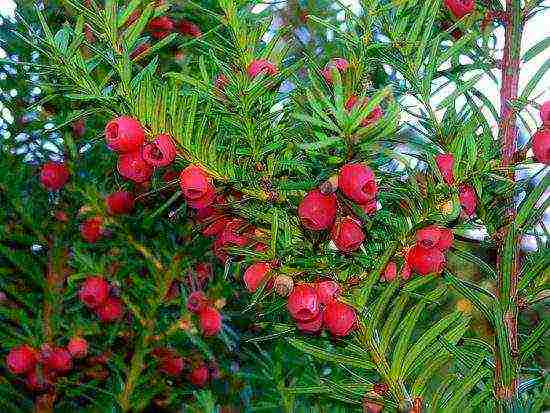
Yew berry fruits
- in autumn, the twigs are covered with bright scarlet berries;
- the root is powerful and branched, capable of drowning out neighboring plants.
You can even choose a suitable variety of yew from a photo. Most requested:
- David. Columnar tree up to 2 m in height with yellow needles. Loves an abundance of light, otherwise unassuming to care for.

David
- Fastigiata. Columnar tree up to 5 m in height with dark green needles. Can grow in the shade. One of the few adapted to growth in urban ecology.
- Elegantissima. A spreading variety up to 1 m high. It does not like drafts, but it is not afraid of drought and light deficiency.
- Washington. A two-meter shrub with yellowish greenery, on which a bronze tide appears by autumn. Does not tolerate excessive moisture.
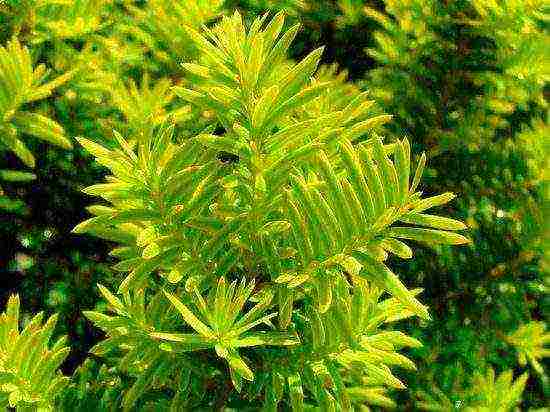
Washington
- Summergold. Very lush undersized shrub with yellowish needles. It is frost-resistant, but does not like lack of moisture.
- Repundance. A low-growing bush with graceful arched shoots. Necessarily requires planting in a sunny place and regular watering.
Attention! The culture is listed in the Red Book.
Yew berry: planting a plant
Berry yew varieties differ significantly in their character. However, there are some common features:
- The culture needs a light, nutritious and well-drained soil. A substrate of peat and river sand (40% each) in combination with leaf turf (30%) has proven itself well.
- Acidity is not a fundamental soil parameter for a plant. The main thing is that it is not sandy.
- Most varieties do not tolerate smoke, gases and heavy deposits in the ground of a large city.
- For the predominant number of varieties of yew, excess moisture in the soil is destructive.
Yew should be planted only in spring. Make a hole about 0.7 m deep in the ground. For a single-row hedge, dig a trench about half a meter deep. There should be at least 2 m between the seedlings. Place the plant in the hole, dig in and water.
Attention! When planting, the root collar should remain above the ground.
Yew berry care
This culture belongs to the north, and in general is able to cope with the vagaries of the Russian weather. Caring for her can be reduced to the following aspects:
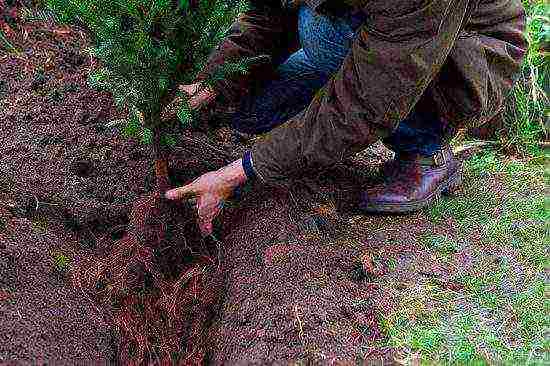
Planting yew berry
- The plant needs regular watering in the first 2 seasons. The norm is 6-10 liters once a month for each tree. Your task is to keep the soil moist, but not overdo it. For example, you shouldn't water the tree if the summer is rainy. And vice versa: in drought, it is better to slightly increase the rate.
- Spray needles to remove dust. This should be done a couple of times a month in addition to watering.
- Yew roots in the first 2-3 seasons are in dire need of air access, so it is better to loosen the soil more often. Depth - up to 15 cm.
- In the first year of life in the open field, cover the near-stem section of the yew with peat or mulch from wood chips with a layer of at least 5 cm.
- Young trees should be insulated at the end of autumn with spruce branches. Adult plants do not need such care.
- From the second year of life in the open field, the yew needs pruning. In early spring, shorten the branches by 1/3. Also remove damaged and dried out shoots. In adult plants, pruning is more thorough, taking into account the varietal characteristics.
Fertilization and feeding of berry yew
In the process of growing, the plant needs several fertilizers:
- When landing. Before placing the seedling in the hole, apply a universal mineral mixture - 100 g / m2.
- Re-feeding with the same complex - 70 g / sq.m.
- Annual fertilization in spring with rotted organic matter - once a season.
- Annual summer feeding with liquid mullein - 2 times a season.
Advice. Dig up the topsoil before fertilizing.
Plant propagation on the site
Reproduction of yew berry in the open field can be carried out by cuttings or seeds. It will take at least 1.5 years to grow seedlings from seeds. First, find the berries. They need to be plucked in the fall:

It is very important to observe the regime of watering the yew berry
- Peel off the pulp. Dry.
- Stratify. To do this, store in a low humidity and temperature of about +5 ° C.
- After a year, the seeds can be sown in fertile and loose soil, under a film. The soil in the pot must be covered with a layer of pine needles.
With this care, about 70% of the seeds should sprout by the spring. Without stratification, the seedlings will have to wait at least three years. But instead of this procedure, you can use chemical treatment for seed reproduction: pour for 30 minutes. sulfuric acid and then rinse vigorously. It is permissible to use both methods at once.
To get a cutting suitable for propagation at the beginning of autumn, find an adult branch and cut it into 15-20 cm segments.At least 3 shoots should remain on each. Peel off the needles from the lower end of the twig and place it in a container. The soil is peat, sand and crushed coniferous bark. In the coming spring, the trees can be rooted. In the open field, they will grow in 7 years, in a greenhouse - in 5.
Advice.For accelerated reproduction and cultivation, cuttings are advised to be treated with a root stimulant before planting.
Diseases and pests of yew berry
When grown in a sunny place with proper care, the plant has a strong immunity to various ailments. Sometimes insects disturb the berry yew:
- yew gall midge;
- yew false shield.

Yew seed
You can find them out from the photo. Popular methods against them are not effective. In both cases, treat the wood with a 2% mixture of karbofos. In the fight against false shield, prophylactic spraying with nitrofen will help until the kidneys swell.
Yew berry: combination with other plants
Depending on the variety, yew can be used to create green hedges, borders, accents in the composition. Figures are also cut out of the tree, which then retain their shape for a long time. The combination of berry yew with other flowering crops is almost always advantageous. The tree looks especially good in a company with juniper, western thuja, Japanese quince.
Planting yew berry: video
It is not difficult to grow yews in the garden. You just need to adhere to the rules for handling them.
Landing place
A place for planting yew trees must be protected from the sun and wind, preferably under a canopy of coniferous and deciduous species. The distance between plants should be between 0.6 and 2.5 m; for large-sized plants - 3-4 m. The root collar remains at ground level. The depth of the planting pit is 60-70 cm.
To plant a hedge from yews, it is necessary to dig trenches. The depth and width of a single-row trench is 0.5 m. A double-row trench should be 0.7 m wide and 0.5 m deep.
Soil for yew
The planting mixture for yews is made up of turf, peat and sand in a ratio of 3: 2: 2. At the bottom of the planting pit, it is imperative to lay drainage - broken brick and sand with a layer of 20 cm.
Certain species have soil preferences. Yew berry can grow on both alkaline and slightly acidic soils. Yew pointed grows on slightly podzolized loamy soils, avoids acidic and waterlogged. Canadian yew prefers slightly acidic soils, but in culture it can grow on neutral ones. Yew middle best on neutral or slightly alkaline soils; it is less picky about growing conditions than others.
Yew care
When planting yew, Kemiru-wagon is applied at the rate of 100 g / m². After a year, the planting is fed with a full mineral fertilizer (nitroammophos) in the amount of 50-70 g / m².
If the weather is dry during the warm season, then the yews are watered once a month, giving 10-12 liters of water for each adult plant. To clean the needles and trunk from dust, yews need sprinkling - once every 2 weeks. If the warm season is rainy, then watering is optional.
Only young plantings should be loosened during the first 2-3 years, especially if there are signs of soil compaction around the trunks. The depth of loosening is 10-15 cm. It is recommended to mulch the space near the trunk with chips or peat, the layer thickness is 8 cm.
Yews tolerate shearing well and strong pruning during crown formation (pruning 1/3 of the length of the shoot). If you want to form a crown, pruning should be done in early spring, in early April. Dry shoots are removed completely.
In the first year after planting, the trunks of young yews must be covered with peat (5 cm layer), then spruce branches. Adult plants hibernate without shelter.
Most often on yews there are “registered” pests - yew gall midge and yew false shield. To combat gall midge, it is necessary to treat with karbofos near-sided circles and crowns in the spring. Against the false shield, plants are sprayed with nitrafen in the spring, before bud break, and in the summer with rogor.
Covering materials for winter
How to check the acidity of the soil?
